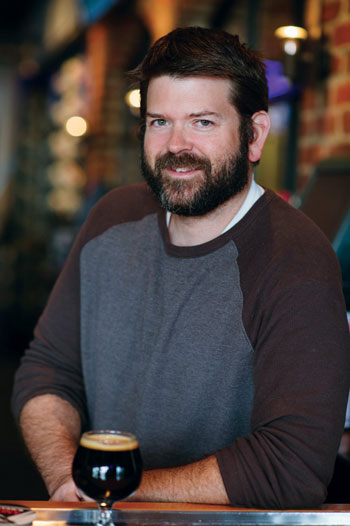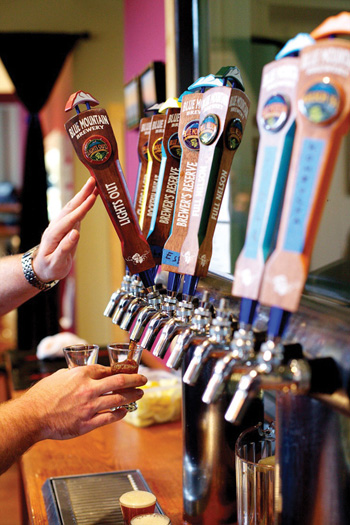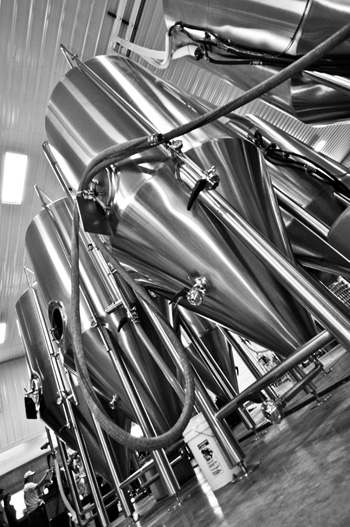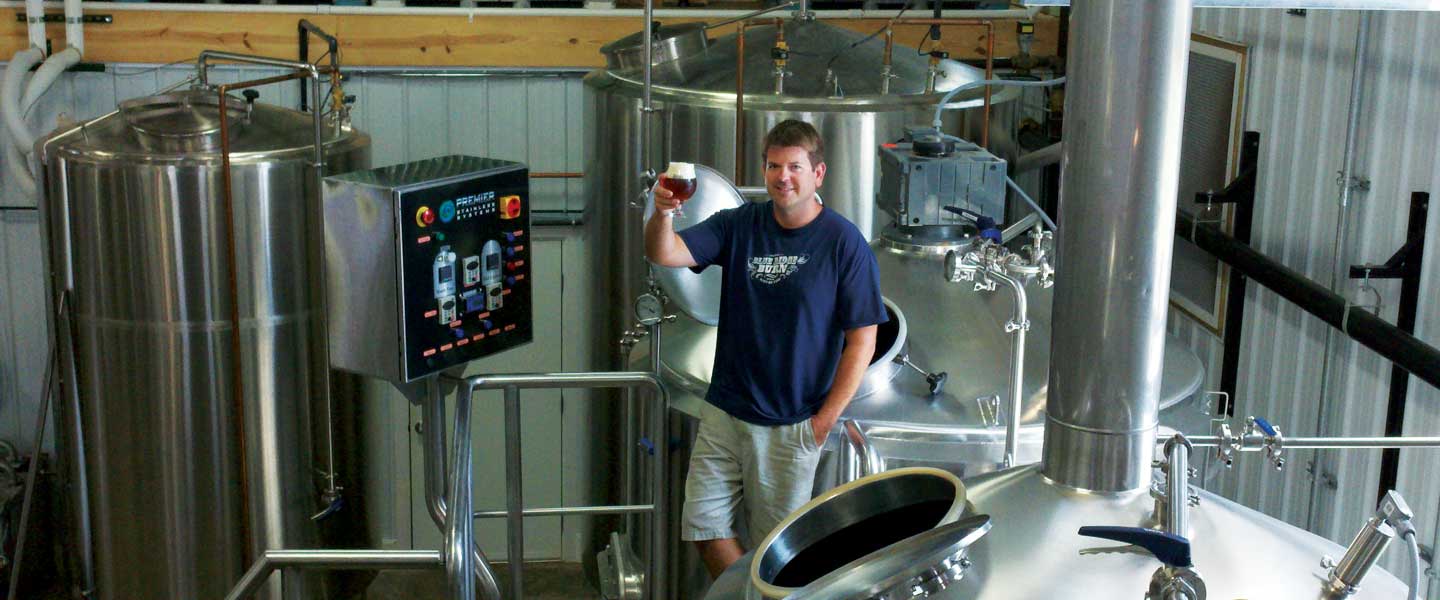From The Record, Spring 2017
Masters of the Craft
 The world’s oldest and most popular fermented beverage is also America’s drink of choice. The earliest colonists brought a taste for ale with them from England and Holland, making beer the most popular libation in colonial times, while heavy waves of Irish and German immigration in the 19th Century further ingrained the beverage in American culture. The popularity of today’s microbreweries and brewpubs continues this American tradition, and two Hampden-Sydney men are at the forefront of the movement. They’ve both won national and international accolades and, between the two of them, brew 15 percent of Virginia’s craft beer. The Record caught up with Taylor Smack ’97 at Blue Mountain Brewery and Robbie O’Cain ’07 at Starr Hill Brewery to learn the secrets of their success.
The world’s oldest and most popular fermented beverage is also America’s drink of choice. The earliest colonists brought a taste for ale with them from England and Holland, making beer the most popular libation in colonial times, while heavy waves of Irish and German immigration in the 19th Century further ingrained the beverage in American culture. The popularity of today’s microbreweries and brewpubs continues this American tradition, and two Hampden-Sydney men are at the forefront of the movement. They’ve both won national and international accolades and, between the two of them, brew 15 percent of Virginia’s craft beer. The Record caught up with Taylor Smack ’97 at Blue Mountain Brewery and Robbie O’Cain ’07 at Starr Hill Brewery to learn the secrets of their success.
Although separated by a decade, the men’s stories share similarities. Both Smack and O’Cain began as homebrewers, a passion that eventually led each one to study at the Siebel Institute in Chicago, the nation’s oldest brewing academy. Both men returned to Virginia and quickly rose to the top of the state’s craft brew scene. And both feel fortunate to work in a field that they love.
For English major Smack, a job as a copy editor right out of H-SC quickly taught him that “cubicle work” wasn’t for him. He started to work for free at South Street Brewery in Charlottesville and within three months decided to take brewing seriously with a move to Chicago. There he found his calling and says, “I feel like I haven’t worked a day in my life since.”
Smack was in the industry for seven years—first as head pub brewer at Chicago’s Goose Island Beer Company, then as head brewer at South Street Brewery—before he launched Nelson County’s first brewery with his wife, Mandi Smack, and business partner, Matt Nucci.
 Critics told them that a brewpub wouldn’t survive in the rural locale, but with its stunning views and close proximity to the Appalachian Trail, Blue Ridge Parkway, Shenandoah National Park, and Wintergreen Ski Resort, Smack saw potential. “Although some people laughed at the idea, it didn’t seem like a risk to me. I knew where craft beer was going in America, and I knew that this hay field in the middle of a rural county was actually the center of a lot of different veins of activity.”
Critics told them that a brewpub wouldn’t survive in the rural locale, but with its stunning views and close proximity to the Appalachian Trail, Blue Ridge Parkway, Shenandoah National Park, and Wintergreen Ski Resort, Smack saw potential. “Although some people laughed at the idea, it didn’t seem like a risk to me. I knew where craft beer was going in America, and I knew that this hay field in the middle of a rural county was actually the center of a lot of different veins of activity.”
What grew out of that venture is Blue Mountain Brewery in Afton, a 10,000-square-foot facility featuring a full-service restaurant, tasting room, and hops yard in the shadows of the Blue Ridge Mountains. With indoor and outdoor seating for 650, the farm brewery has become a destination for beer enthusiasts and foodies alike. At any given time on an average Saturday, some 1,000 people will be visiting Blue Mountain, for a total of a quarter million patrons each year.
According to Smack, “Our idea was to create a beautiful atmosphere, get people out of the city, and re-associate beer as an agricultural product—replicating what the wineries did for wine. Beer has become so industrialized and urbanized, but it’s just malted barley, hops, and yeast, which all come from farms. So, we grow our own hops to give people the touch and feel of the product.” The first of its kind in Virginia, Blue Mountain Brewery has become a model for the state’s growing number of rural breweries.
Smack opened a second facility in 2012; the Blue Mountain Barrel House in Arrington brews and packages beer destined for distribution and features a barrel room where ale is aged for an average of three months. An alternating cycle of warm and cool temperatures mimics the natural seasons and draws the bourbon and char flavors out of oak barrels that Smack purchases directly from craft distilleries. The new facility packages 15 types of beer; together, the brewery’s two locations produce some 40 styles of brew each year.
Things came full circle in 2014, when Smack purchased South Street Brewery to save it from closing 15 years after he first volunteered there. Although the demands of running three small businesses with 150-plus employees keep him fully occupied, Smack still spends one day a week brewing beer at the Afton location. “It helps me keep it real,” he jokes. “I didn’t become a brewer to answer email full-time.”
 Smack says that “craft beer is a meeting of art and science, and we make room for a lot of creativity.” While Smack is clearly passionate about the art of beer, master brewer Robbie O’Cain is equally passionate about the science of it. “Brewing is engineering, it’s thermodynamics, it’s biology, it’s chemistry,” he says. “It’s basically the entire science department all rolled into one.”
Smack says that “craft beer is a meeting of art and science, and we make room for a lot of creativity.” While Smack is clearly passionate about the art of beer, master brewer Robbie O’Cain is equally passionate about the science of it. “Brewing is engineering, it’s thermodynamics, it’s biology, it’s chemistry,” he says. “It’s basically the entire science department all rolled into one.”
The chemistry major’s first exposure to brewing came in his sophomore year at Hampden-Sydney when he brewed mead in Dr. Kevin Dunn’s chemistry class. Returning to his native Asheville, North Carolina, after graduation, he found a lively craft beer scene and became a devoted home brewer. Although he took a job with Wachovia Bank, by 2011 he decided to pursue a career in brewing, and he needed to educate himself in order to do so. His degree at the Siebel Institute included 11 weeks of study in Germany, fostering his meticulous focus on quality and efficiency.
O’Cain’s first job in the industry was cleaning tanks and moving hoses at Virginia’s largest independent craft brewery. But “cleaning is chemistry,” according to O’Cain, so he tackled the work with a determined attitude and the scientific approach that he learned at H-SC. For example, he studied the sanitation processes of the pharmaceutical industry, adopting practices that he admits are “overkill,” because “overkill is what you want when it comes to sanitation.”
He moved up quickly at Starr Hill Brewery in Crozet, becoming the quality assurance manager within a year and the manager of brewing operations just two years later. In those roles, O’Cain introduced scientific advancements like a devoted lab with a UV spectrometer to ensure quality control and improved product, and a centrifuge to clarify the beer without the use of non-renewable resources. He also developed new recipes and refined existing ones, winning prestigious awards at the World Beer Cup and the Virginia Beer Cup.
A tour of the brewery with O’Cain is a science lesson that moves quickly from the metabolism of yeast and its effect on the aroma of hops to the acceleration of oxidation caused by diatomaceous earth. But it’s not just his scientific knowledge that led Starr Hill to name him their Brewmaster in 2015. On the business side, his attention to detail and analysis of data led to significant improvements in efficiency and cost-effectiveness. On the management side, his team mentality and interest in his employees’ personal wellbeing helped maintain a positive work environment. And, of course, O’Cain’s work ethic and willingness to take initiative set him apart; he says, “At the end of the day, it’s not just the hours you work. It’s your attitude while working, it’s how much you accomplish, and it’s how dedicated you are.”
Just like Smack, O’Cain doesn’t consider his hours at the brewery as work, per se. “I get to do what I love every day, so much so that I sometimes forget that many people don’t love their jobs. I’m extraordinarily lucky to have found both enjoyment and meaning in my work.”
With their breweries only ten miles apart from each other on the Brew Ridge Trail of Albemarle and Nelson Counties, the two Hampden-Sydney men see each other quite frequently. And although they are competitors of sorts, O’Cain calls it “a healthy competition.” Starr Hill’s focus on distribution and Blue Mountain’s focus on the brewery experience means they’re both attracting new consumers to the craft beer market. And with both brewers winning medals at the most recent Great American Beer Festival—the nation’s most prestigious beer competition, where 7,227 beers from 1,752 breweries competed for 280 medals—they’re attracting serious attention to the region’s growing craft beer industry.
Long before the first shipment of European beer arrived in the New World in 1607, Native American tribes fermented corn to produce a beer-like brew. And although apocryphal stories about the founding fathers and beer abound—including a recently debunked myth about James Madison proposing a national brewery—historical documents confirm that George Washington and Thomas Jefferson used homebrew to supply their households’ needs. Washington’s handwritten recipe for porter was found in his personal notebook, and the father of our nation proposed the first “buy American” policy in a 1789 letter: “I use no porter or cheese in my family, but such as is made in America.” As for Jefferson, his earliest plans for Monticello included a brew house, and in 1794 he planted his first hops in the plantation’s famed gardens.
In 1810, America was home to 140 commercial breweries, a number that grew to 4,141 by 1873. But the landscape changed drastically over the next century, seeing almost 4,000 breweries close. Prohibition stalled the industry, of course, yet in 1935 almost 800 breweries remained. Technological advances in production and shipping led national brands to supplant local breweries, however, while the rise of home refrigeration increased the demand for packaged beer, causing a massive decline in brewpub sales. And industry consolidation meant that by 1980, a mere five corporations produced more than 75 percent of American beer.
The emergence of the modern craft beer industry can be traced to an act of Congress in the late 1970’s, when only 89 breweries remained in America. President Carter’s signature on H.R. 1337 legalized home production of beer for personal consumption and opened the door for an army of home-brew hobbyists, a handful of whom entered the industry with brewpubs and microbreweries. By 1986, the U.S. was home to six microbreweries; within a decade, that number rose to 365 and surpassed 500 in 2009.
Over the past five years, craft beer has abandoned its steady rise and exploded as the fastest growing segment of the 252.6 billion-dollar beer industry. Fueled by the rise of brewpubs, in 2015 the United States reached the highest number of breweries in its history—4,269—passing the benchmark set in 1873. Thankfully for enthusiasts nationwide, the availability and innovation of craft beer continues to grow, with another 1,800 craft breweries in the works for 2017, according to the Brewer’s Association.
